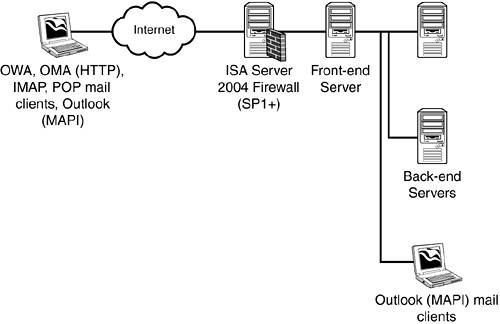Understanding Back-End Servers
| Back-end servers are the servers that do most of the work in an Exchange front-end and back-end server topology. All the email service requests are forwarded from the front-end servers to back-end servers, which are considered the workhorses of the Exchange architecture. Because there can be multiple servers in a front-end and back-end architecture, load balancing can be configured to spread the access requests across all the servers. Splitting the client requests among several back-end servers optimizes messaging performance and provides a scalable server architecture. Typical Scenarios for Back-End ServersAs the workhorses of the Exchange organization, back-end servers can be configured as a single server or a farm of multiple servers serving a front-end server or servers. The basic architecture looks like Figure 2.4. As you can see, the figure contains email clients, a front-end server to proxy requests, and a back-end server to process the requests and store the Exchange information. Figure 2.4. Basic placement of back-end servers.
An advanced architecture shown in Figure 2.5 includes a firewall in addition to the front-end server to enhance the network and server environment and help prevent unwanted persons from accessing the server directly. In this scenario, the firewall and the front-end server are the focal points for intruders, not the back-end server where sensitive user and organization data is held. Figure 2.5. Advanced placement of back-end servers.
As shown in Figure 2.6, another scenario exists where there are multiple networked mail servers located behind the front-end server, also known as a server farm. A back-end server farm streamlines internal processes by distributing the workload between the individual servers of the farm using network load-balancing technology and expedites computing processes by harnessing the power of multiple servers. The load-balancing software tracks demand for processing power from different computers, prioritizing the tasks, and scheduling and rescheduling them depending on network user priority and demand. When one server in the farm fails, another can step in as a backup. Figure 2.6. Front-end and back-end architecture with a back-end server farm.
These are just a few of the configurations that can be architected in an Exchange deployment. Make sure that you research and deploy the configuration that best fits your organization. |
EAN: 2147483647
Pages: 130


